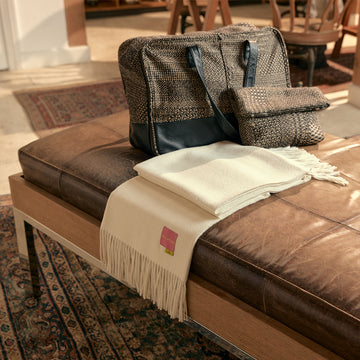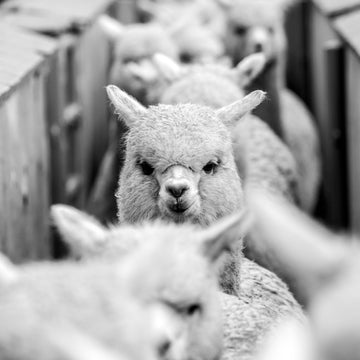Sustainable Alpaca
The alpaca is a noble and generous animal, legendary and sensitive. In Peru, it is a national symbol dating back to 5000 BC. Today, 80% of the world's population of this camelid is found in the Peruvian Andes. Each of these alpacas represents the work and progress of thousands of Peruvians who live far from modern life. For them, raising alpacas means preserving a vestige of ancient history. For us, it is keeping history alive and making every day our reason for being.
In addition to their cultural importance, alpacas provide a durable, sustainable and unique fibre, in a context where fashion is increasingly disposable, plastic and homogeneous. We believe there are four central reasons to promote and use this wonderful raw material.

Alpacas are kind to the earth
Alpacas feed only on the tops of grasses and other plants. By not pulling them out of the ground, they disturb the vegetation less and allow it to grow back.
Their efficiency is particularly remarkable, as alpacas require less feed than most other fibre-producing livestock. They also eat natural pastures, so no land or water needs to be used to grow their feed.

Alpacas save energy
Alpaca fibre is classified into more than twenty-two natural colours. These originate from nine pure colours: white, light beige, light camel, beige, light brown, brown, grey, brown-black and black, with many other subtle shades and nuances. This saves the dyeing process, which is the most intensive in terms of water, chemicals and energy.
Alpaca fiber is an excellent insulator, both for heat and cold. Due to this property, household products made from this fiber, such as rugs, blankets, bedspreads and curtains, are very popular and useful.

Alpacas are present in history
Alpaca is a Spanish word derived from the Aymara name allpacu or the Quechua names pacos or pacoshas. Cave paintings dating back more than 8,000 years refer to the interaction between ancient Peruvians and alpacas.
The use of alpaca fiber in textiles began around 2500 BC and became increasingly important over time in ancient Peruvian cultures.
For more than a million small-scale alpaca farmers in the central Andes of South America, these animals are a fundamental pillar of their livelihood. Alpacas are also an extremely significant element of cultural identity.

Products made from alpaca fiber are unique
The fineness of alpaca fibre ranges from 18 microns to over 35 microns, making it possible to make all kinds of garments: from extremely fine and light products to thick blankets with significant thermal properties.
The physical characteristics of alpaca fiber allow for the production of durable products with superior performance in extreme climates, both cold and hot.

But our fascination with the alpaca was born not only because of its obvious beauty or the story behind it, nor because of its magical and unique fibre, recognised around the world. For us, the world of the alpaca is full of lessons that we have decided to apply to everything we do. If you want to know more about this majestic animal and its sustainability credentials, you can visit whyalpaca.com.
Author: Andres Chaves







